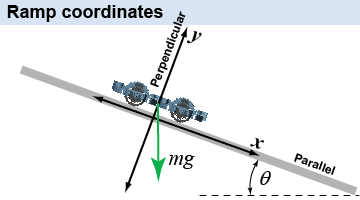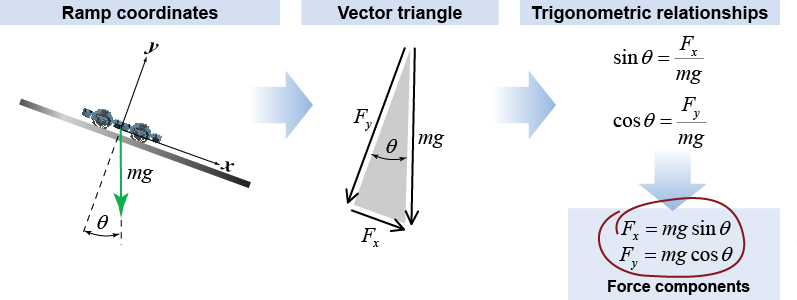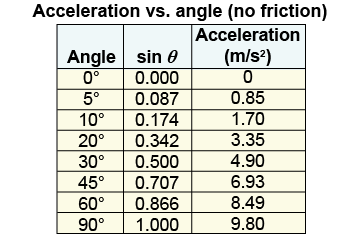|
 Consider a car (or ErgoBot) moving on a ramp that makes an angle θ relative to the horizontal direction. There are forces both parallel and perpendicular to the ramp surface. It is convenient to define ramp coordinates in which the x-axis is along the direction of motion and parallel to the ramp. The y-axis is then the direction of the normal force.
Consider a car (or ErgoBot) moving on a ramp that makes an angle θ relative to the horizontal direction. There are forces both parallel and perpendicular to the ramp surface. It is convenient to define ramp coordinates in which the x-axis is along the direction of motion and parallel to the ramp. The y-axis is then the direction of the normal force. 
|
The car’s motion depends on the net force in the x-direction (along the ramp). Because the ramp is at an angle, the weight force is not vertical in ramp coordinates but is tilted at the ramp angle. A component of the car’s weight equal to mg sin θ lies parallel to the ramp surface. This component causes the car to accelerate down the ramp at ax = g sin θ. 
|

|
| (6.12) | | | ax | = | acceleration along ramp (m/s2) | | g | = | acceleration of gravity = 9.8 m/s2 | | θ | = | ramp inclination angle (degrees) |
| Acceleration
in ramp coordinates |
|
 The table on the right shows how the acceleration of the car varies with the angle of the ramp. The acceleration varies as the sine of the ramp angle. The sine of 0º is 0, and the acceleration of a horizontal ramp is also zero. The sine of 90º is 1, and a vertical ramp has an acceleration of 9.8 m/s2, the same as free fall.
The table on the right shows how the acceleration of the car varies with the angle of the ramp. The acceleration varies as the sine of the ramp angle. The sine of 0º is 0, and the acceleration of a horizontal ramp is also zero. The sine of 90º is 1, and a vertical ramp has an acceleration of 9.8 m/s2, the same as free fall. 
|
Notice that for shallow angles the acceleration is small. This means that the force along the ramp is also small. This works to great advantage, because you can push a load up a ramp using a force smaller than the weight of the load. The ratio Fx/mg is the sine of the inclination angle. At an angle of 10º the sine has a value of 0.174, so it only takes 0.174 N of force applied parallel to the ramp to raise each newton of weight. Used this way, the ramp is a simple machine, which you will learn more about on page 345. 
|
Calculate the acceleration of a car on a ramp when the ramp’s inclination angle is either 0° or 90°, and explain physically why you got those answers.
 |
When the inclination angle is 0°, the ramp is not inclined at all—it is a level surface, parallel to the ground. So the acceleration of the car along the surface is zero, because the acceleration due to gravity is perpendicular to the surface (and because sin 0° = 0 in the equation ax = g sin θ).
When the inclination angle is 90°, the ramp is inclined vertically, and the car accelerates as if it were in free fall. The acceleration is then equal to g, because sin 90° = 1. 
|

